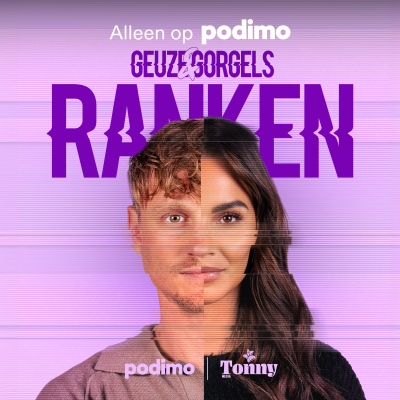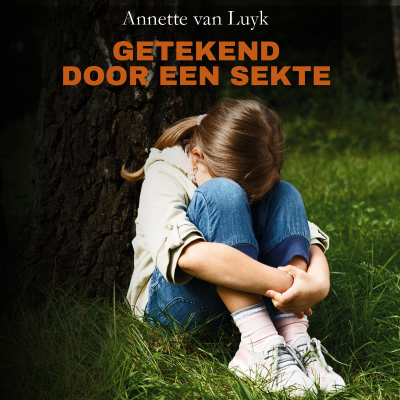
Red X Podcast: Ending Human Trafficking and Modern Slavery
Engels
Nieuws & Politiek
Tijdelijke aanbieding
1 maand voor € 1
Daarna € 9,99 / maandElk moment opzegbaar.
- 20 uur luisterboeken / maand
- Podcasts die je alleen op Podimo hoort
- Gratis podcasts
Over Red X Podcast: Ending Human Trafficking and Modern Slavery
Red X Podcast exists to raise awareness of human trafficking in North America and empower everyday people to work with their local municipalities to create a safe place for citizens, a hostile environment for criminals, and a second chance for survivors. Host, Nicole Bernard, is the director of Second Life North Carolina. Nicole is the mother of four. She initially learned about human trafficking on the international scale but discovered that trafficking was happening in her own community about five years ago. Nicole served Transforming Hope Ministries, which has now merged with Second Life North Carolina. Producer and Engineer, Lance Olive, is the Mayor of Apex, NC and host of the Apex Roundup Podcast. He knows that the topic of human trafficking can be massive and that attending conferences or seminars can leave us overwhelmed and wondering what can be done. His goal is to produce a show that helps the listener to be able to approach the topic of trafficking in “bite sizes” so that you can easily introduce the issue to friends, family, neighbors and co-workers easily and encourage action at a local level. We bring new episodes every couple of weeks that include news, interviews with experts (law enforcement, policy makers, investigators, survivors, foundations and more) to help provide deep insight into how human trafficking has thrived in North America so we can all work together to find ways to stop it for good. Our hope is that you not only listen, but also provide us feedback and tips that we can share in future episodes. We sincerely thank you for being a part of this podcast!
Alle afleveringen
21 afleveringenRXP019-Tasha-Levert Role of Pornography
Host Nicole Bernard talks with Dr. Tasha Levert of Broomtree Counseling about the role of pornography in the world of human trafficking.
RXP020 COVID-19 Panel Discussion
The Red X Podcast presents a special panel episode to explore the effect of the Coronavirus Pandemic on human trafficking and the anti-trafficking community. Guests include Leanne McCallum [https://redxpodcast.com/2019/01/07/017/] from the Greater New Orleans Human Trafficking Task Force [http://www.nolatrafficking.org/], Melissa Rueschhoff who worked in Hawaii's AG office as an analyst/special prosecutor in the ICAC unit (currently working with policy and is the legislative attorney for a state representative in Hawaii), and Nick Lembo coordinator for the Just Men Arizona/Epik Project [http://aatnaz.org/wp-content/uploads/2017/11/Just.Men_.Promo_.pdf] and Shared Hope International [https://sharedhope.org/] board member. This panel discussion focuses on how the Covid-19 pandemic and social isolation is impacting service providers, vulnerable populations, and demand. Melissa says that anti-trafficking groups in HI have all had to shift from face to face conversations to online communication for their main service providers. Mentoring and education programs have gone online; instead of meeting in person or in groups discussions and check-ins have moved to online platforms to serve clients. Leanne also says that phones and online platforms are replacing client meetings. She says that social distancing has affected how clients are able to get to appointments and services. And, unfortunately some clients are not able to get housing at all. In order to protect victims from virus they’ve had to limit the number of clients they allow into shelters. One shelter in NOLA has had to make the difficult decision of only allowing victims under the age of 21 to be able to be housed in their shelter. But what about demand? Nick explains that the EPIK Project was already working through online and phone platforms. A group of men cyberpatrol communities. In other words, they post decoy ads that men respond to and a cyberpatroler then interacts with that potential buyer and tries to educated them on the reality of what they are attempting to engage in. They have worked with law enforcement and survivors on the best ways to approach these men. Patrols typically employ 4-5 men. Information collected on these intercepted transactions are then reported to law enforcement. Nick says that a week prior to recording, buyers were still active in spite of growing national concerns about social distancing and spread of the virus.Nick was most interested in ads in Seattle, Washington the state in which was hard hit by the pandemic. He asked the men if they were concerned and they were not concerned about spread of virus. As Nick explains, “addictions don’t take holidays”. And although calls may have been down by about 10-15%, people who are home and have a lot of idle time are responding to decoy ads to purchase sex. Buyers are already taking risks and it seems that the threat of viral spread is not a deterrent. Melissa has been in contact with Homeland Security. Her contact there also affirms that buyers and traffickers are still active and that law enforcement agents are still combatting them. However, they are expecting are a lot more children being at risk of child pornography and being lured from online sources now that children are home from school and on the internet. The longevity of social distancing measures gives perpetrators a chance to build a rapport with the victims through online communications—a main way of luring someone into trafficking. Victims often they believe they are in a relationship with the perpetrator. Law enforcement is also going online to intercept and combat these transactions. Leanne says that isolation can lead to a variety of crimes. There’s an entire spectrum of abuse and violence that we may see because of the pandemic. Where there’s a lack of opportunity, people may turn to the gray economy. There will be employers who want to take advantage of people’s economic vulnerability. Demand is not just about commercial sex, it’s also about labor. We still need people to produce medical supplies, food, and other essential items. It’s possible some will use labor trafficking to produce those goods. Although Leanne says they haven’t seen direct reports of forced criminal behavior they are simply getting less intel from community partners and have a lessened law enforcement presence, which may explain why they aren’t seeing it. She says that they do see this pattern in times of natural disaster. When a tornado hits, they see undocumented people repairing roofs and not getting paid. After Catrina, forced labor was being used to repair infrastructure. People who are homeless or in the margins are at greater risk of being exploited by false promises of fair work. The Better Business Bureau is doing PSA’s about false businesses that are luring people in. Exploitation may be happening online. Nick references an article [https://nypost.com/2020/03/14/business-booming-for-cam-girls-amid-coronavirus-outbreak/]in the NY Post says that camming is on the rise. Also, Pornhub is offering free premium subscription and that there is data linking porn use to being a sex buyer. Shared Hope International [https://sharedhope.org/what-we-do/prevent/awareness/internetsafety/]and Arizona Anti-trafficking network are trying get the word out about internet safety. Melissa suggests some concrete steps parents can take to protect their youth from cyberexploitation: * Check in with your children. What social media are they using? Make sure they are using privacy settings * Sync your device to your child’s. What information is being sent and received? * If youth own a cell phone, where did they get it and why are they using it? * Are youth allowed to have the cell phone in their rooms? Turn phones over to their parents at night. * Remind children never to give out their address, their name, their school name or other personal information. * Remind children to never agree to friend or to meet someone in person they just met online. * Remind children what’s appropriate to post online and not. Even one image can stay on the internet forever. * Monitor apps. How did they meet the people they are talking to through them? Encourage youth to be cautious. It’s difficult for children to understand how something they do now will affect them in the future, so it’s important for parents to be vigilant about how children are interacting online. How could the pandemic and social isolation affect vulnerability to trafficking? Leanne says that human trafficking doesn’t happen in a vacuum. There’s a whole spectrum of abuse that can happen. Child abuse and domestic violence may increase for some as children and domestic partners may be in close proximity to their abusers. Also stress may exacerbate the abuse. Additionally, there are far fewer interactions for people to disclose their abuse or to find ways to get away. In terms of elder abuse, it isn’t possible for some family members to be in touch with their elderly families. Staff may be stressed and overworked due to staff shortages, which could lead to abuse or neglect of elderly clients; this also applies for residential institutions serving people with disabilities. Furthermore, elders may be at risk of financial exploitation. Looking ahead, how can we plan to combat trafficking following the pandemic? Melissa says we need to look at our state laws. Are our laws strict enough for perpetrators? If not, we need to change those so we can prosecute buyers and traffickers. We also need to make sure that we are reaching out to the vulnerable. Leanne says that they are encouraging case managers to really address what basic needs clients may be saying they need. They are also suggesting for survivor services to integrate risk management into their care. And for providers themselves, how do they reduce vicarious and secondary trauma so they can continue to serve well. She says that service providers need to think about contingency plans and sustainability plans in case they fall ill and create transition plans for someone else to take over if they can no longer serve. Leanne has created a toolkit [https://docs.google.com/document/d/1TMwGbYbexQejRqmgK6veNs2P1JQwTGTTHyf-peOpvlI/edit] for service providers. Nick adds that men can join the efforts in combatting trafficking by starting a men’s group to begin cyberpatrol [https://www.endslaverynow.org/epik]. The work they do educates buyers, supports law enforcement, and identifies traffickers.
RXP018 Karen Lambie Foster Parenting
Dr. Karen Lambie joins Lance and Nicole to talk about the foster care system and how it crosses paths with the trafficking of children. Lance and Nicole welcome Sonya Edwards, a volunteer for Shield North Carolina [http://www.shieldnc.org/]and foster mother. Sonya and Nicole interview Dr. Karen Lambie, a Shared Hope [https://sharedhope.org/]Ambassador on the link between foster care and human trafficking. As the nation becomes more aware of human trafficking, it seems that the public’s reaction is to cling to tightly to their children in parks and stores. Media stories circulate about a mothers and young children followed in large businesses such as Costco or Ikea and the assumption is that kidnappers are lurking, ready to grab a toddler at the first instance that the mother looks away. But according to the National Center for Missing and Exploited Children, less than 1% of missing children are from non-family abductions; [http://www.missingkids.com/footer/media/keyfacts]and although those abductors have only nefarious intent, even that 1% is not comprised of all human trafficking. However, of the 23, 500 runaways reported to the National Center for Missing and Exploited Children, one in seven were trafficked. Traffickers are typically looking for vulnerable youth to prey on. Children without homes or family. Kids who have already experienced neglect and abuse so that they can be more easily manipulated. Given those facts, it should come as no surprise that, according to the National Foster Youth Institute [https://www.nfyi.org/issues/sex-trafficking/], 60% of trafficking victims have had the foster care system in their history. In 2018, there were more than 400,000 children in foster care. In 2014, the US passed the Preventing Sex Trafficking and Strengthening Families Act [https://www.congress.gov/bill/113th-congress/house-bill/4980], which requires each state’s plan for foster care and adoption assistance to develop policies and procedures for children within their care who might be trafficking victims. The Family First Prevention Act [http://www.ncsl.org/research/human-services/family-first-prevention-services-act-ffpsa.aspx]also seeks to improve the quality of foster care by giving state agencies the option of using funds on prevention care for foster candidates to keep children placed with their families. Although there are national and state efforts to improve the foster care system, more attention must be focused on preventing trafficking within the system. Foster children often run away from their placements, however it was until the past decade that states started passing legislation that mandated missing children from foster care be reported. Not all foster families or social workers are given adequate training on identifying the signs of human trafficking and in many states, there is a lack of resources for children who have been identified as trafficking victims. Given the realities, to effectively address the exploitation of children, we must take a hard look at one of our country’s most burdened but overlooked social services: the foster system. Dr. Karen Lambie has a PhD in educational psychology. There is a complex relationship between foster care and commercial sexual exploitation of children. As a foster parent, Karen learned about this connection as a foster mother. Karen had a young girl in her home who had become pregnant through her stepfather trafficking her for drug money. In her case, she was trafficked by a family member (familial sex trafficking) before she entered foster care. There are some foster parents that will actually traffic their foster children. Sonya had a child in her home who was trafficked by uncle in Texas. She was originally from Honduras and then sold to another ring in Tennessee. Karen says that 60-80% of our trafficked children are in foster care or have been in foster care prior to. In considering children in general who are at-risk, adverse childhood events (ACE’s) must also be considered. ACE’s could be suicide of a family member, domestic violence, drug dependency, etc. These ACEs make children more vulnerable; ACE’s are often what puts children at risk of trafficking. Foster children often want to run away in the foster care system. Running away puts them at very high risk. 1 in 3 children who run away are approached by traffickers within the first 48-72 hours. Traffickers are looking for them at homeless shelters. If traffickers may use children in a shelter to recruit others within the shelter. Truck stops and bus stops are other places where children may go. Lyn Leeburg of Truckers Against Trafficking provided information on outreach through the trucking industry. [https://redxpodcast.com/2018/07/14/012/] What are some signs that a foster child might be trafficked or is being trafficked? Grades might start to drop, the mood might change to anger or depression, if they become secretive, if the child is on drugs (traffickers often use drugs to control them), tattoos/branding, evidence of physical abuse, burn marks in areas covered by clothing, or the child may have new items of value that the trafficker has purchased for them. Tattoos may be in a place on a child’s inner lip. The Slave Across the Street by Theresa Flores [https://www.amazon.com/Slave-Across-Street-Theresa-Flores/dp/0982328680/ref=sr_1_1?crid=1TDJE6YYXU2L&keywords=the+slave+across+the+street+by+theresa+flores&qid=1581051066&sprefix=The+Slave+Ac%2Caps%2C143&sr=8-1]tells the story of how she was trafficked by some high school boys in the 80’s. For 18 months she was trafficked while also going to school. Theresa was from a 2 parent, stable home. Often these children feel like “throw-aways” and so they may stay with their trafficker who makes them feel wanted. The trafficker may also use elements of fear and there may be trauma-bonding that makes it difficult for the child to leave. NCMEC said that 1 in 7 of the 25,000 runway children are actually trafficked. These children may be in a strange city, cold, hungry and homeless and may take up someone on an offer. Part of the solution is to teach the kids the signs that traffickers use, internet safety, and the dangers of running away. But how realistic is it that a 14 year old girl will not get lured in? Karen says that these conversations need to be a continuous part of school curriculum and parents should also be educated to talk to their kids about these dangers? Florida passed legislation to do human trafficking prevention in elementary through high school. It’s also important to equip a community to be a safety net and educate peers on the signs if they have a friend who might be being trafficked. Boys are also trafficked and the element of shame is often even higher in boys. It’s important to approach the children very delicately. Also important to connect to the right resources such as a court appointed advocate for foster children and a certified counselor. The child in Sonya’s home who was trafficked was threatened that money would not be sent to her father. She saw her trafficking to support her impoverished family. In the case of Theresa Flores, the trafficker threatened to harm her younger brothers. Another sign of trafficking may be dressing in a very sexual way for a young child. Sonya said that her foster child needed intensive in-home therapy to in part help her understand how to adapt to being a teenager. Karen says that foster care does not have enough services for victims or people who are trained to respond to their trauma. There are physical problems and lots of psychological problems. Appropriate counseling can help them cope with the psychological components. In one example of sex trafficking that was reported on a previous podcast episode [https://redxpodcast.com/2017/11/25/002/], offering a recovering victim inappropriate resources and counseling for their specific trauma can just lead to more trauma. Also, Dr. Heather Pane-Seifert [https://redxpodcast.com/2017/12/23/004/](on a previous episode) gives some insight into why trafficked children behave the way they do—their behaviors may help them survive. Treatment that reduces these survival behaviors if the child is still being trafficked may put them in danger. Sonya says that she was not equipped to handle a trafficked child when she became a foster parent. Karen says that anyone who is working with children, especially foster parents, needs to be educated on the signs of, response to trafficking. Where can people learn more about supporting foster care? If you don’t want to be a full time foster family, you can offer respite care to existing families. If you have organizations within your community that collect items that these children might need, this helps foster families who often have to spend their own money for the children’s’ needs. Shield North Carolina has a Service Groups and Faith Alliance—we’re hoping that a network like this can help provide support to foster families’ needs. Traffickers, buyers, and victims often all have childhood trauma in their past. In preventing trafficking, it is essential to address this trauma. Wings of Shelter [https://wingsofshelter.com/index.html]offers training. I want to tell you a little bit about Shield North Carolina [http://www.shieldnc.org/]. I started Shield North Carolina two years ago as a mom that was disgusted at the reality of people trafficking children for sex. We believe in a world where kids can live free of fear of exploitation. We are primarily focused on prevention efforts at the community level and are currently developing a prototype for responding to trafficking and supporting restoration at the municipal level for other grassroots movements to replicate. We’ve been a part of passing legislation at the municipal and state level and are currently working on federal legislation to create greater restitution for child pornography victims. Our approach is to be relentless, collaborative and bring together best practices from across the country. Please consider making a donation to Shield North Carolina so we can continue this important work. Go to www.shieldnc.org [http://www.shieldnc.org/]to make a donation. We are careful stewards to make your dollars count in turning the tides in the anti-trafficking movement so that next generations can live in a world where kids fulfill their purposes and never have to worry about being sold. www.shieldnc.org [http://www.shieldnc.org/]Can follow us on facebook. Can you become a monthly donor?
RXP-DC Pop Up Episode from Washington, DC
Nicole Bernard of Shield NC and Erin Wallin report on their progress in Washington DC as they meet with influencers to help develop legislation and executive orders to help fight human trafficking and facilitate better restitution for survivors (i.e. victims).
RXP017 Leanne McCallum New Orleans Zydeco
Guest Leanne McCallum of the Greater New Orleans Human Trafficking Task Force. Zydeco. Christmas Tree. Sugar Bowl. Gators.
Kies je abonnement
Tijdelijke aanbieding
Premium
20 uur aan luisterboeken
Podcasts die je alleen op Podimo hoort
Gratis podcasts
Elk moment opzegbaar
1 maand voor € 1
Daarna € 9,99 / maand
Premium Plus
Onbeperkt luisterboeken
Podcasts die je alleen op Podimo hoort
Gratis podcasts
Elk moment opzegbaar
Probeer 30 dagen gratis
Daarna € 11,99 / month
1 maand voor € 1. Daarna € 9,99 / maand. Elk moment opzegbaar.

































